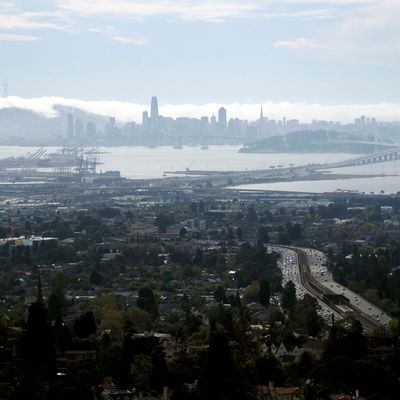
California’s largest utility is planning to cut power to a total of 800,000 homes before the end of the day Wednesday in an attempt to reduce the power load and prevent wildfires during excessively windy and dry conditions. Pacific Gas & Electric is calling it a “public safety power shutoff,” and it began just after midnight Wednesday, with half a million homes going dark. Another 300,000, many in the Bay Area, will lose power before the day is through. And other utilities in California are considering following suit as the state hopes to avoid another devastating fire season.
Who is in the dark and for how long?
The first phase of intentional shutdowns left 513,000 Northern California homes without power early Wednesday morning. At noon Pacific Time, another 234,000 homes will be powered down. PG&E is also considering another 42,000 shutdowns in its southernmost service areas.
These figures represent the customers who will lose power, not the total number of people affected. According to KCBS reporter Doug Sovern, cutting power to 800,000 customers will leave around 2.5 million people without power.
A map shows approximate areas where shutdowns will occur, but PG&E has warned that this is a “general guideline.” The utility has provided a tool on its website where residents can enter their addresses and see if their power is set to go out.
Southern California Edison is also considering cutting power to customers in Los Angeles and San Bernardino counties, the utility said this week. As many as 139,000 homes could be left without power as Santa Ana winds reach speeds as high as 70 mph.
The shutdowns are expected to last through Thursday, or until dangerous winds whipping through the state calm. Once the winds have slowed, PG&E must inspect its equipment for damage and perform repairs before turning the power back on. To expedite that process, 45 helicopter crews and 700 additional inspectors are on standby to begin evaluating equipment as soon as weather permits.
The utility doesn’t sound confident that this will be over quickly. Customers are being asked to prepare for an “extended outage” given the “prolonged period during which the wind event will unfold, and the large number of power line miles that will need to be inspected before restoration.”
Why is power being shut down?
The intentional shutdown is happening because of the extreme winds forecasted to hit Northern and Central California on Wednesday. The dry, powerful gusts could reach speeds up to 70 mph, leading the National Weather Service to issue a “Red Flag Warning,” its highest level of warning for potential fire danger.
By shutting off power, PG&E is hoping to prevent downed power lines from igniting dry brush. “The safety of our customers and the communities we serve is our most important responsibility, which is why PG&E has decided to turn power off to customers during this widespread, severe wind event,” PG&E senior vice-president Michael Lewis said this week.
The shutdowns come a year after wildfires, later blamed on PG&E, devastated large parts of the California. The Camp Fire was the largest wildfire in California history, killing 85 and destroying 19,000 buildings. In May, the California Department of Forestry and Fire Protection said downed power lines owned by PG&E caused the blaze.
PG&E first intentionally shut off power for public safety last October, when 60,000 Northern California customers were left in the dark to prevent potential wildfires.
How are people reacting to the shutdown?
PG&E’s decision to cut power has been widely criticized in California. Oakland mayor Libby Schaaf said the utility should be maintaining its power lines better so the strong winds wouldn’t lead to such drastic measures. “This is the type of interruption to lives that should not happen,” she said this week. “We are going to do it because we agree it is in the interest of the safety of people, but we have got to do better.”
Consumer advocates at the Utility Reform Network have also blasted PG&E for not using the high fees it charges customers to strengthen its network. “We have spent billions of dollars and we have huge rate increases just for PG&E to fix their system,” a group spokesperson told ABC 7 News. “And I think people are upset because it has not been done yet.”
What are people supposed to do without power?
Many will be staying home, with public schools and some universities closed across the state. In San Jose, residents have been encouraged to shelter in place, devise emergency plans, and prepare kits with food and water. At a press conference, Mayor Sam Liccardo urged residents to prepare for as many as seven days without power.
On Wednesday, PG&E planned to open resource centers with charging stations, bottled water, and air-conditioned seating for up to 100 people.
Many residents have reacted by stocking up on essentials, emptying store shelves of batteries, food, and water. Some water utilities have asked customers to have as much as two gallons of water per person per day on hand. Though they have backup generators, they’ve said the shutdown could affect water delivery.





























